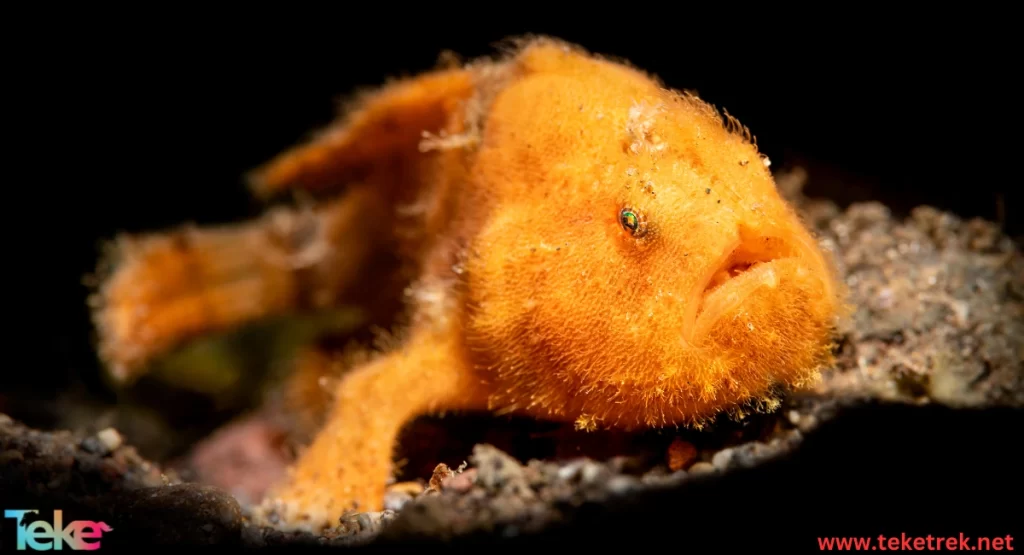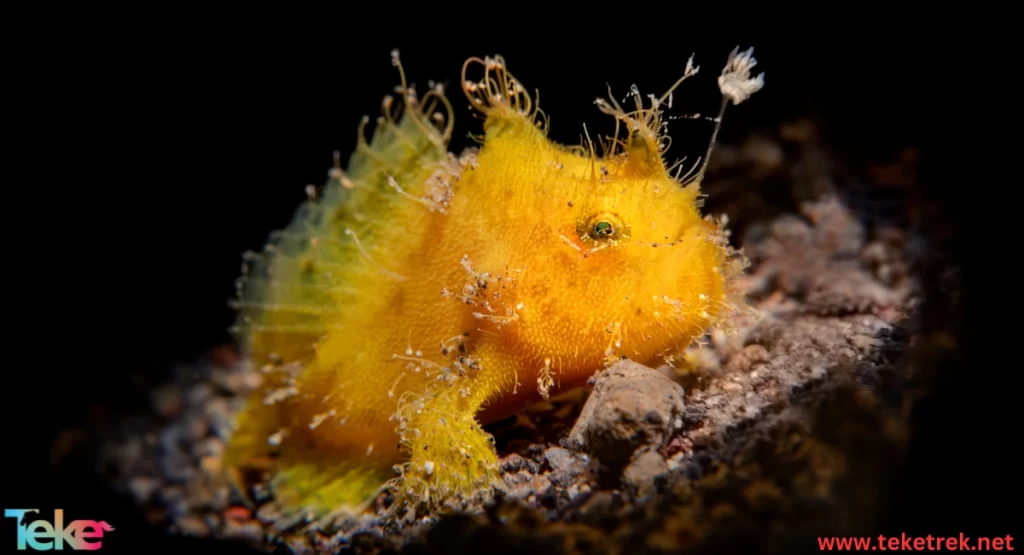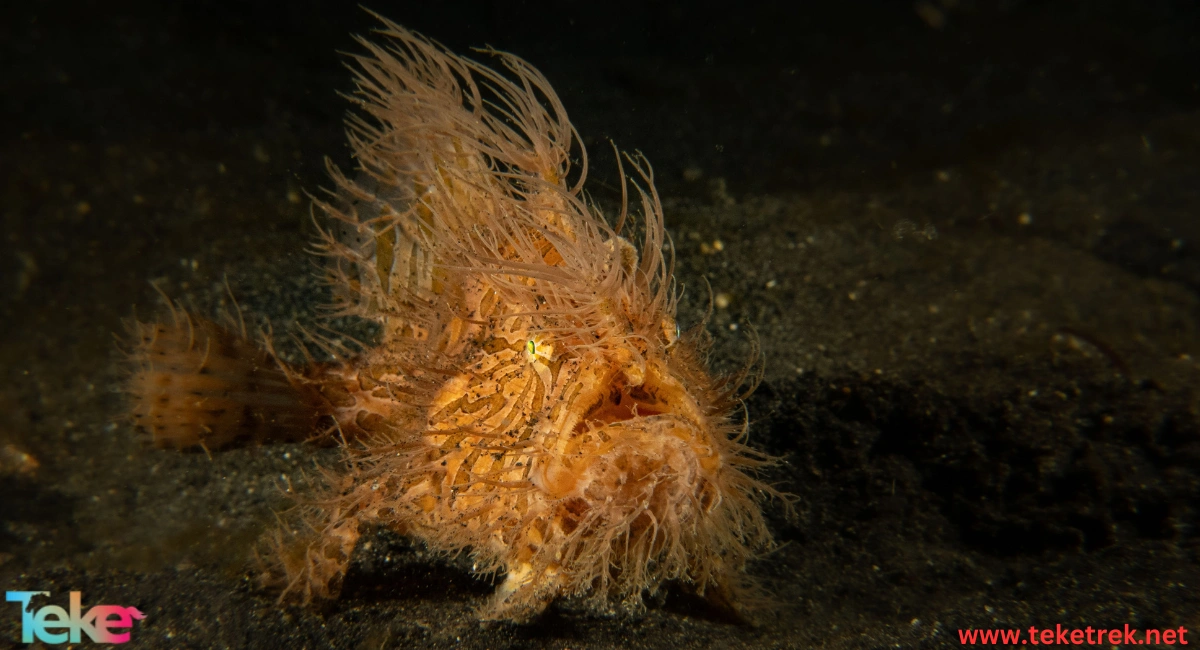Giant Frogfish: Unique Aquatic Creatures
Giant frogfish are one of the unique animals that live in aquatic environments. These creatures are well-camouflaged and adapted to their surroundings, making them rarely discovered. In this article from teketrek, we will discuss the giant frogfish, their lifestyle, diet, and characteristics.

Habitats of the Giant Frogfish:
The giant frogfish, belonging to the genus Antennarius, are part of the chordates, subphylum vertebrates, and class Actinopterygii.
They have a wide range and can be found throughout the tropical Pacific Ocean, the eastern Atlantic Ocean, the eastern Pacific, as well as in Hawaii (Kona), the Indian Ocean, Japan, the Red Sea, tropical Australia, the western Atlantic Ocean, Indonesia, and Asia.
Frogfish exhibit various color forms throughout their life cycle.
Giant frogfish are aquatic animals found in coral reefs, lagoons, protected rocky reefs, and structures like sea piers.
They prefer shallow waters averaging 20 meters deep but can be found at depths of up to 70 meters.
Physical Characteristics of the Giant Frogfish:
Known as Giant Frogfish, they are members of the family Antennariidae and can grow up to 15 inches long.
Giant frogfish are poor swimmers like all frogfish and use their pelvic and pectoral fins to “walk” along the seabed to anchor themselves in place for ambush.
Like other members of the frogfish family, the giant frogfish have an expandable spherical body with a large mouth. The lower jaw of the giant frogfish extends forward more than the upper jaw, allowing it to swallow prey as large as itself.
They can change color to match their background, making them appear completely camouflaged.Nevertheless, it controls its gray or black colors, or red, orange, pink and brown.
The giant frogfish also have skin that allows them to blend better with their background.
Wart-like protrusions and scab-like color changes help the fish resemble the corals and rocks they hide in.
Dark spots on the skin are designed to look like holes in the coral.
Diet of the Giant Frogfish:
Giant frogfish are carnivorous predators, but since they (and all frogfish) are poor swimmers, they need to find a different hunting strategy to search for and find food.
They use their near-perfect camouflage to hide and their strong pelvic and pectoral fins to anchor themselves in place.
However, they don’t wait hopelessly for something to pass by; they have a trick up their sleeve.
Like a true hunter, the frogfish have a specialized lure called Illicium, which they use to attract prey.
Frogfish are known to be indiscriminate and voracious predators, happily eating anything as large as themselves, even other frogfish.
It is known that it is attracted to divers because they bother the fish, giving it the opportunity to have a meal.
Some of them have been seen eating up to 7 fish in 10 minutes.
Reproduction Stages of the Giant Frogfish:
Giant frogfish are solitary creatures that spend their time hidden among the coral reefs and sponges in their coral reef habitat, patiently waiting for prey.
The only time giant frogfish come together is for breeding, and if the male stays too long after being eaten by the female.
The female begins producing eggs a few days to several hours before mating.
Her stomach swells noticeably as the eggs absorb water, and a single female can produce between 40,000 and 180,000 eggs.
About two days before laying the eggs, the male giant frogfish begins to approach the female.
It is unknown what triggers spawning?
It could be moon phases, secreted hormones, or another external factor.
Egg guarding is a task that falls to the male, and the egg diameter ranges from 0.5-1 mm.
After the eggs float on the surface in the current for about 5 days, they will hatch.
The fry first survive on the yolk sac still attached after eating it, living as plankton until they develop into a mature frogfish about one inch long.
At this point, they will swim to the seabed and live on the bottom as mature frogfish.

Frequently Asked Questions About the Giant Frogfish:
- Can the giant frogfish swim?
These fish are classified as poor swimmers and are relatively stationary fish that tend not to move much but stay in soft sand or mud most of the time.
- Is the giant frogfish amphibious?
No, it is not amphibious; the giant frogfish are aquatic animals that live in the seas.
- Where was the giant frogfish discovered?
This species of fish was discovered near the shores of the Maldives¹.
- Is the giant frogfish poisonous?
Yes, it is a poisonous fish that contains **tetrodotoxin** in its liver, skin, and muscles¹.
- What are the unique characteristics of the giant frogfish?
It is characterized by having only four teeth in its mouth and the ability to inflate its body like a balloon fish. It is also considered lazy in hunting for food, tearing fishermen’s nets to devour escaping marine creatures¹.
- What challenges do fishermen face because of the giant frogfish?
These fish pose a challenge to fishermen, especially in Turkey, where they enter their nets and tear them, causing them annoyance and loss.
In conclusion
, the giant frogfish reflect the wonderful diversity and amazing adaptations in marine life. Our understanding of this marine creature can enhance our appreciation for the complex ecosystems in the oceans and the importance of preserving them. Thanks to its exceptional abilities, the giant frogfish remains a vital part of the marine environment, contributing to maintaining ecological balance and biological diversity in the depths of the seas.
References





